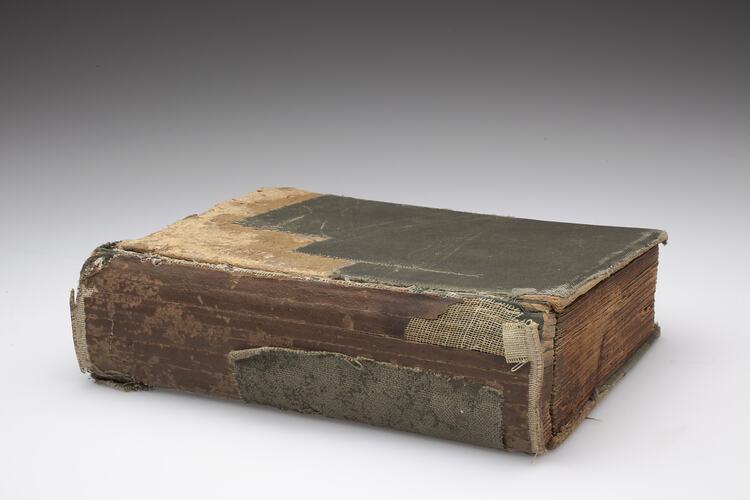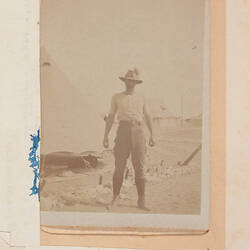Summary
Album of photographs believed to have been taken by Australian serviceman George Simpson Millar, 5th Australian Light House, Gallipoli, 1915. Contains 103 small black and white photographs.
The photographs, apparently sent back home, depict life in Gallipoli 1915, as well as war ships, the Suez Canal, Gibraltar, a hospital ship, trenches, men massing for battle, a soldier reading a letter, soldiers at rest, cutting hair, etc., tunnels, and individual soldiers, graves and shell holes. A few photographs of France are included.
On the back of the front cover is an obituary from 1915 of 'The late T.G. Millar', the father of George Simpson Millar, the owner of the album. According to the article, George, the oldest of three children (two boys & a girl), was fighting in the Dardanelles and France with other Australians at the time of the funeral. Perhaps George was born in NSW where his parents were married and then moved to Queensland where his father held the position of honorary treasurer to the United Pastoralists' Association. Another article, pasted opposite, describes the wedding of George's sister Miss Nancie Millar, for which he was absent. Her address appears inside the front cover of the photograph album.
A poem has been written in the front cover but has been mainly obscured by a photograph of 'No Man's Land', Ypres, 1917.
Trooper George Simpson Millar, service #160, was born in St Kilda. He was a 23-year-old an unmarried pastoralist when he enlisted on 1 October 1914. He was sent to Gallipoli on 16 May 1915, and on 22 August was shipped out, suffering from scalded hands. He was transported to England, and on 1 September was admitted to the 1st London General Hospital. On 25 October (or December) 1915 he was discharged to take up a commission in the Royal Field Artillery Special Reserve in the Imperial Army, where he became a lieutenant. On 9 January 1918 he resigned from the Imperial Army and rejoined the AIF, this time appointed as lieutenant. He was sent to fight in France, and in August was back to England suffering asthma and haemorroids. He returned to Australia in January 1919.
Physical Description
Photograph album, containing 101 black and white snapshots, small, mainly of Gallipoli and some of France. The album has a green cover and is bound in brown. Most photographs have a caption written underneath in ink. The first photographs are taken from a troop ship travelling through the Suez Canal; at Cape Hellos, Gallipoli; Lord Nelson (ship) with torpedoes out in Suvla Bay, Gallipoli; other troop ships in Lemnos Harbour and Suvla Bay; a hospital ship off 'Anzac'; Gibraltar; groups of Australian soldiers on deck of ship; soldiers on beds on poop deck; a nursing sister, Frances Bennet, on the S.S.Caledonia, Gibraltar; men at rest on a ship deck, and in a temporary hospital ward (?) on board ship; convalescent soldiers outside a hospital in England; hospital wards; then views of Anzac, including Loop Hold, 5 Light Horse, Anzac, overlooking Turkish lines; From 5L.H. lines to Gaba Tepe; G.S.M. [Millar] with foal from Murphy's mule, Shell Green; [note that Simpson, who was famous for carrying wounded Australian soldiers under fire at Gallipoli, was also known as 'Murphy'.] 'only photo in existence of event, massing for 8 Aug. attack'; Turkish trenches from 5L.H. trenches, taken through loop holes; (one loop hole shows torn canvas); 'Dead Aust. & rifle in No Man's Land'; man in shorts with hat, with hand-written legend on it: ""G.S.M. in remains of his dugout'; a second photograph shows the same soldier (Millar) reading a letter; view of trench, titled 'Ken Hamilton (with rifle), Alan Duke sitting'; view of two soldiers in hollow with canvas stretched behind them: both are smoking a pipe; a group of soldiers in a trench with a billy: canvas rigged up perhaps for shade; soldier with gun and ammunition in a trench with sand bags; photo of man outside tent in hollow marked 'Geo. Huges having hair cut'; (on the back of this photograph is written 'Two Longreach bushmen - Hamilton (Camoold Park) cuts the hair of Geo. Hughes' ) (This photograph is taken by Geo. S. Millar). soldier with hat emerging from a shelter with a blanket behind him, identified as 'Harry Hammond'; another soldier, standing, identified as 'Archie Croone'; soldier Don Fraser standing against cliff and sea; view of trench with three soldiers crowded together; view of dug-outwith two men eating.
More Information
-
Collection Names
Returned and Services League (RSL) Collection, Military Memorabilia Collection
-
Collecting Areas
-
Acquisition Information
Donation from Victorian Branch, Returned & Services League of Australia Limited (RSL), Dr Millar, 24 Feb 1986
-
Place & Date Depicted
-
Place & Date Depicted
-
Photographer
Lieutenant George S. Millar - Australian Imperial Force (AIF), 1915-1916
Photographer, 44th Battalion, 3rd Division, 1st A.I.F. -
Organisation Named
-
Inscriptions
On the first page of the album is written 'no. 160 Trooper Geo. S. Millar 'A' Troop 'C' Squadron. 5th A.L.H. Regt. [Australian Light Horse Regiment] 2nd A.L.H. Bde. [Australian Light Horse Brigade] A.I.F.' [Australian Imperial Force]. The 5th Australian Light Horse regiment was part of the 2nd Light Horse Brigade.
-
Classification
-
Category
-
Discipline
-
Type of item
-
Overall Dimensions
21 cm (Length), 16 cm (Width), 5.5 cm (Height)
-
Keywords
Australian Army, Militaria: Australian, Portraits, Wars & Conflicts, World War I, 1914-1918, Making History - War Diaries and Correspondence

